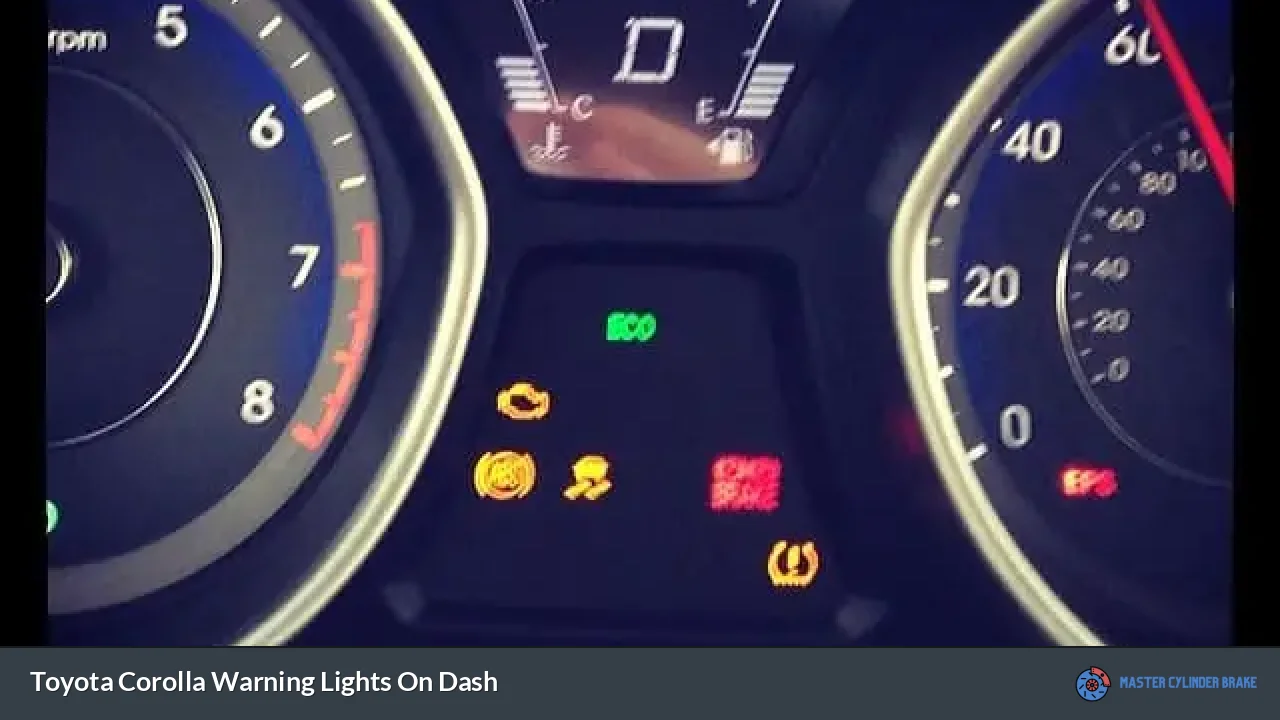Are you driving your Toyota Corolla and suddenly notice warning lights illuminating on the dash? Don’t panic! These little icons serve as your car’s way of communicating with you, indicating potential issues that require your attention. Understanding what these warning lights mean can save you from costly repairs and keep you safe on the road.
One common warning light you might encounter is the check engine light. When this light comes on, it’s like a red flag waving at you, signaling a problem with your vehicle’s engine or emission system. It could be something as simple as a loose gas cap or a more serious issue like a malfunctioning sensor. It’s crucial not to ignore this warning, as it could lead to further damage if left unchecked.
Another important warning light to be aware of is the oil pressure light. This light resembles an old-fashioned oil can and indicates that your engine’s oil pressure has dropped below a safe level. Low oil pressure can cause significant engine damage, so it’s vital to pull over safely and turn off the engine immediately when you see this light. Check your oil levels and consult a professional if required.
If you see a battery icon lit up, it means there might be an issue with your car’s electrical charging system. This could be due to a faulty alternator, a worn-out battery, or loose connections. Ignoring this warning could result in a dead battery and a stranded vehicle. Have a mechanic inspect and address the issue promptly.
The ABS warning light alerts you to a problem with your Anti-Lock Braking System. When this light is illuminated, it indicates a malfunction that may affect your vehicle’s braking performance. Your regular brakes will still function, but the anti-lock feature might not engage properly during emergency stops. Seek professional assistance to diagnose and fix any ABS issues.
Decoding the Dashboard: A Comprehensive Guide to Toyota Corolla Warning Lights
Have you ever been driving your trusty Toyota Corolla and suddenly noticed a mysterious warning light illuminating on your dashboard? It’s a common occurrence that can leave any driver scratching their head in confusion. But fear not! In this comprehensive guide, we’ll dive deep into the world of Toyota Corolla warning lights, decoding their meanings and helping you understand what action to take when they appear.
Let’s start with one of the most common warning lights: the check engine light. When this little symbol resembling an engine pops up, it’s your car’s way of telling you that something isn’t right under the hood. It could be a minor issue like a loose gas cap, or it could indicate a more serious problem with the engine system. Either way, it’s wise to schedule a visit to your trusted mechanic for a diagnostic check.
Next up is the tire pressure warning light. Picture a cross-section of a tire with an exclamation mark inside, and you’ve got yourself the tire pressure warning light. This handy indicator lets you know when your tire pressure is too low, potentially compromising your safety and fuel efficiency. Keep a close eye on your tire pressure and inflate them to the recommended levels as soon as possible.
Now, if you see a red exclamation mark surrounded by parentheses, that’s the brake system warning light. It means that there may be an issue with your braking system, such as low brake fluid or worn-out brake pads. Your vehicle’s stopping power is crucial, so don’t delay in having it inspected by a professional.
Moving on, we have the battery warning light. It looks like a simple rectangle with a “+” and “-” sign inside, representing your car’s electrical system. If this light comes on, it suggests a problem with the charging system or a weak battery. Ignoring it might lead to a sudden breakdown, so get your battery and charging system checked promptly.
Last but not least, the ABS warning light deserves attention. Shaped like letters “ABS” inside a circle, it indicates an issue with your Antilock Braking System. While your regular brakes may still work fine, the ABS may not engage properly in emergency situations. Seek professional help to diagnose and fix the problem.
Understanding the meaning behind Toyota Corolla warning lights is crucial for every driver’s safety and peace of mind. By familiarizing yourself with these symbols and taking appropriate action when they appear, you can keep your Corolla running smoothly on the road. Remember, if in doubt, consult your owner’s manual or seek professional assistance. Safe travels!
Toyota Corolla Owners Beware: What Those Dashboard Warning Lights Really Mean
Introduction:
Hey there, fellow Toyota Corolla owners! Have you ever been driving along and suddenly noticed a warning light blinking on your car’s dashboard? If you have, don’t panic! In this article, we’re going to dive into the world of Toyota Corolla’s dashboard warning lights and uncover what they really mean. So, buckle up and let’s get started!
Understanding Your Dashboard Warning Lights:
Your Toyota Corolla is equipped with various dashboard warning lights that serve as an early warning system for potential issues with your vehicle. These lights are designed to grab your attention and alert you to specific problems that require your immediate attention. Ignoring them could lead to more significant and costly repairs down the road.
Check Engine Light:
The most notorious of all dashboard warning lights is the check engine light. When this little orange light illuminates, it means that your vehicle’s onboard diagnostic system has detected a problem with the engine or emissions system. It could be something as simple as a loose gas cap or something more serious like a faulty sensor. To determine the exact cause, it’s best to have your vehicle diagnosed by a qualified mechanic.
Oil Pressure Warning Light:
Another crucial warning light you need to be aware of is the oil pressure warning light. This light looks like an old-fashioned oil can and indicates low oil pressure in your engine. Low oil pressure can lead to engine damage if not addressed promptly. Stop your vehicle immediately, check the oil level, and consult your owner’s manual for further instructions.
Battery Warning Light:
When you see a battery-shaped warning light on your dashboard, it means there’s an issue with your vehicle’s charging system. This could indicate a failing alternator, a loose or damaged belt, or a weak battery. Don’t ignore this warning light, as it could leave you stranded with a dead battery.
Conclusion (Not included):
Now that you’re armed with some knowledge about the Toyota Corolla’s dashboard warning lights, you can be more confident in handling these situations. Remember, it’s essential to address any warning lights promptly to ensure your vehicle performs optimally and remains safe on the road. Stay tuned for more valuable insights into your beloved Toyota Corolla!
So there you have it, Toyota Corolla owners! Keep an eye out for those dashboard warning lights and take appropriate action whenever they appear. Your car will thank you for it, and you’ll enjoy a smoother and worry-free driving experience. Safe travels!
Illuminating Insights: Understanding the Most Common Toyota Corolla Dash Warning Lights
Have you ever been startled by a sudden glow on your Toyota Corolla’s dashboard? Those mysterious warning lights can certainly catch you off guard. But fear not, as we delve into the world of Toyota Corolla dash warning lights and shed some light on their meanings.
One of the most common warning lights you may encounter is the check engine light. This little icon resembles an engine and can leave you wondering what could be wrong under the hood. Typically, it indicates an issue with the engine or its components. It’s advisable to have a professional mechanic diagnose the problem to prevent any potential damage.
Next up is the battery warning light. Shaped like a battery, this light serves as a reminder to check your vehicle’s charging system. If this light appears, it suggests that your car’s battery is not charging properly, which could lead to a breakdown if left unattended. It’s crucial to address this issue promptly to avoid getting stranded unexpectedly.
Another important warning light is the tire pressure monitoring system (TPMS) light. When you see an exclamation mark inside a horseshoe-like symbol, it means that one or more of your tires might be underinflated. Proper tire inflation is vital for safety and fuel efficiency, so make sure to check your tire pressures regularly and inflate them to the recommended levels.
Additionally, the oil pressure warning light demands attention. It resembles an oil can dripping oil. This light indicates a drop in oil pressure, which could be caused by a variety of reasons, including low oil level or a malfunctioning oil pump. Insufficient oil pressure can be detrimental to the engine’s health, so stop safely and seek professional assistance immediately.
Lastly, let’s talk about the ABS warning light. When you see the letters “ABS” surrounded by a circle, it signifies an issue with the anti-lock braking system. While your regular brakes may still function, the ABS may not engage during sudden stops or slippery road conditions. To ensure optimal safety, have a qualified technician inspect and repair the system.
Understanding these common Toyota Corolla dash warning lights can save you from potential headaches and costly repairs. Remember, when in doubt, consult your vehicle’s owner manual or seek professional assistance. Stay informed, stay safe on the road!
Critical Signals: How to Interpret and Respond to Toyota Corolla Dashboard Warnings
Introduction:
Imagine cruising down the road in your Toyota Corolla when suddenly, a mysterious symbol lights up on your dashboard. Panic sets in as you wonder what it means and whether it’s something serious. Understanding the critical signals emitted by your Toyota Corolla’s dashboard is essential for maintaining your vehicle’s health and safety. In this article, we’ll explore common warning symbols found on the dashboard and provide insights on how to interpret and respond to them.
-
The Engine Warning Light:
One of the most crucial dashboard warnings is the engine warning light. When this light illuminates, it signifies a potential issue with your vehicle’s engine or its related components. It’s important not to ignore this warning, as it can indicate problems ranging from a loose gas cap to more severe engine malfunctions. To avoid further damage, pull over safely, check the gas cap, and inspect other visible factors. If the issue persists or you suspect a serious problem, seek professional assistance immediately. 
The Battery Warning Light:
The battery warning light is an indicator that your vehicle’s charging system requires attention. It could suggest a faulty alternator, worn-out battery, or other electrical problems. When this warning pops up, it’s advisable to examine your vehicle’s battery connections for corrosion or looseness. If the problem persists or you experience difficulties starting your car, consult an automotive expert to diagnose and resolve the issue promptly.

The Oil Pressure Warning Light:
The oil pressure warning light warns of low oil pressure, which can lead to detrimental engine damage if ignored. Safely pull over and check the oil level using the dipstick. If the oil level is within the recommended range and the warning light remains lit, it’s best to contact a professional technician to avoid engine complications.-
The Brake System Warning Light:
When the brake system warning light flashes, it indicates potential issues within your Corolla’s braking system. It could imply anything from low brake fluid levels to malfunctioning ABS (Anti-lock Braking System) components. First, verify that the parking brake is fully disengaged. If the light persists, avoid driving and have your vehicle inspected by a qualified mechanic to ensure optimal braking performance.
Conclusion:
Your Toyota Corolla’s dashboard warnings are crucial signals that shouldn’t be ignored. By understanding these critical indicators and responding appropriately, you can safeguard your vehicle’s well-being and protect yourself and others on the road. Remember, if you’re ever unsure about a dashboard warning, it’s always wise to consult a professional who can provide expert advice and assistance.
